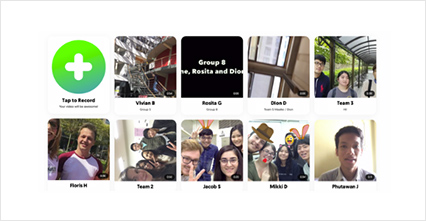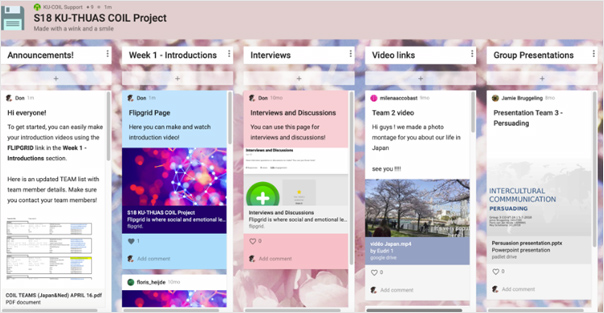2019.03.14About COILCOIL Course Example
Kansai University x The Hague University of Applied Sciences (Spring Semester 2018)
COIL Course Example 2
This is an example of a standard COIL project that represents a 6-7 week exchange and collaboration that might be suitable for those instructors and educators that have established a partner relationship prior to commencement of course delivery. This example features collaboration between Kansai University (Japan) offering an undergraduate course on Critical Thinking Skills for Social and Global Issues, and The Hague University of Applied Sciences (Netherlands) offering an undergraduate course on Intercultural Communication - 2 in Spring/Summer term 2018.
This collaboration was designed and planned prior to commencement of both courses. It was conducted primarily as an asynchronous collaboration given the time difference between Japan and the Netherlands.
The participants included 31 Kansai University students and 25 HUAS students. Students also included international exchange students enrolled in the courses (e.g., those undertaking one or two semester exchange programs).
The design of this COIL was to enable students to participate in an exchange with international students with a particular focus on providing opportunities for intercultural communication, intercultural interaction, reflection on cultural (and linguistic) challenges, and for students to collaboratively complete one or two projects working in diverse teams.
The rationale of the COIL was that the topic of communication and how people come to evaluate knowledge from a range of sources was very much at the core of both courses. The students at HUAS were majoring in business related areas and the students at Kansai were from a wide range of social sciences and humanities areas.
| icebreaking 3 weeks |
Students used padlet and flipgrid to exchange brief introductory videos (as individuals or groups). Students then made and exchanged group videos illustrating some aspect of local culture. |
|---|

| project collaboration 3 weeks |
Students in the Netherlands interviewed students in Japan (using text or video) on communication topic. Students in Japan critically analyzed the interviews. |
|---|

| outputs | Students in the Netherlands prepared and delivered presentation on intercultural communication. Students in Japan provided critical review of presentations and interviews. |
|---|
Image:Overview of the COIL project
Icebreaking


Image:Example of introductory videos on flipgrid
During the first-week students were allocated to teams (8 in total), given instructions on how to make brief introductory videos using flipgrid, and introduced to padlet as the platform by which students and instructors could post messages about group membership, host videos, and host final presentations.
The icebreaking phase of the COIL required students to participate in two tasks. The first task required students to make a brief video introduction using flipgrid, with a particular emphasis on making team introductions (i.e., team in Japan and Netherlands would exchange videos). The instructors also made an introduction video or PowerPoint which were shared in class sessions.
The second task required students to produce a more elaborate video in which they documented some aspect of local life and culture that they considered routine or mundane, in order to facilitate further discussion between team members. These were then hosted on padlet (all students could then view the presentations). For example, one team in Japan documented their visit to a ramen restaurant and provided commentary on how to order various dishes and request services. While not a requirement, many teams used some form of multimedia authoring or editing app to produce their final video productions.
Project Collaboration


Image:Padlet showing organization of topics and tasks
Following the icebreaking phase the students (in groups) collaborated on the main project which was to explore how intercultural communication styles may influence how people provide and respond to different types of feedback (i.e., positive or negative). There were however two different learning outcomes for each group of participants. Students from HUAS had their primary focus on being able to empirically investigate the topic through the use of interviews, while for KU students the focus was on how to critically analyze the products of such investigations by being both a participant and investigator.
This was undertaken to ensure that the learning outcomes for each group of students were appropriately addressed in the COIL exchange, and to generate some possible ideas for future collaborative projects with a tighter integration.
In practice, this involved the HUAS students undertaking interviews with their KU team members (by use of video chat or text exchange) on topics of intercultural communication. The KU team members then provided their reflections on both the interviewing process and the findings presented as updates. It is important to note that students were free to choose how they were to undertake these activities, and it was anticipated that students were likely to encounter a range of cultural and linguistic challenges in organizing both the interactions between and within the teams. This was considered as a feature, rather than a problem, particularly given that the aims of the two courses were to explore issues relating to intercultural communication and practical and applied aspects of critical thinking.
Outputs
For final outputs, HUAS students produced presentation materials (e.g., PowerPoint slides) detailing their main findings from the interviews and interactions as they related to intercultural communication topics. The KU students provided ongoing evaluations of claims made as participant/observers in terms of their rhetorical and logical sensibility and provided in-class summaries at the conclusion of the project. KU students were evaluated with participation in COIL activities making them eligible for at least a course passing grade.
Summary of Key Elements
| Courses | Critical Thinking for Social and Global Problems (Kansai University, Japan) Intercultural Communication - 2 (Hague University of Applied Sciences, Netherlands) |
|---|---|
| COIL Type | Standard COIL (6-7 weeks) |
| COIL Rationale | Shared aims of courses relating to communication and exploring cultural elements of critical thinking and analysis. Opportunity for intercultural communication and interaction while engaged in practical project-based work. |
| Students | 56 undergraduate social science/humanities and business students. |
| Collaborative Tasks | Introduction videos Cultural exchange videos Interviews and reflective analysis Presentations |
| Key Tools |
|